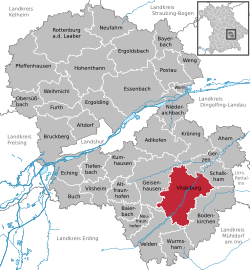Vilsbiburg
| Vilsbiburg | ||
|---|---|---|
 |
||
|
||
| Coordinates: 48°27′N 12°21′E / 48.450°N 12.350°ECoordinates: 48°27′N 12°21′E / 48.450°N 12.350°E | ||
| Country | Germany | |
| State | Bavaria | |
| Admin. region | Lower Bavaria | |
| District | Landshut | |
| Government | ||
| • Mayor | Helmut Haider (Freie Wähler) | |
| Area | ||
| • Total | 68.85 km2 (26.58 sq mi) | |
| Elevation | 449 m (1,473 ft) | |
| Population (2015-12-31) | ||
| • Total | 11,535 | |
| • Density | 170/km2 (430/sq mi) | |
| Time zone | CET/CEST (UTC+1/+2) | |
| Postal codes | 84137 | |
| Dialling codes | 08741 | |
| Vehicle registration | LA | |
| Website | www.vilsbiburg.de | |
Vilsbiburg (German pronunciation: [fɪlsˈbiːbʊʁk]) is a town on the river Große Vils, 18 km southeast of Landshut, in the district of Landshut, in Bavaria, Germany. Vilsbiburg has 11,000 inhabitants.
Vilsbiburg lies in the center of Lower Bavaria and is part of the Alpine foothills. The river Vils runs through the town center. Vilsbiburg is about 55 miles northeast of Munich.
The first mention of a village named Pipurch is found around 1000 AD. In records dating back to 1308, Vilsbiburg is mentioned as a market and also as a town, having a court and municipal powers. Vilsbiburg officially acquired the status of a town in 1929. On July 1, 1972 the administrative district of Vilsbiburg was merged into Landshut. The former municipalities of Frauensattling, Gaindorf, Haarbach, Seyboldsdorf and Wolferding became part of the town of Vilsbiburg in 1978.
Vilsbiburg is twinned with:
...
Wikipedia



